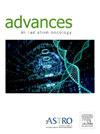A Phase I/II Study of Ultra-Hypofractionated Carbon-ion Radiation therapy for Low- and Intermediate-Risk Localized Prostate Cancer
IF 2.2
Q3 ONCOLOGY
引用次数: 0
Abstract
Purpose
We report herein the 3-year results of a phase I/II prospective study of 4-fraction course of carbon-ion radiation therapy (CIRT) in patients with localized prostate cancer.
Methods and Materials
The present was a single-institution, phase I/II prospective study including patients with low- or intermediate-risk prostate cancer, as defined by the National Comprehensive Cancer Network criteria. Eligible patients were randomly assigned (1:1) to a 1- or 2-week schedule. Dose-limiting toxicities (DLTs) were defined as any genitourinary (GU) or gastrointestinal (GI) toxicity grade 3 or higher within 90 days of beginning CIRT. Ten patients were enrolled in each group, and the CIRT dose was increased in a stepwise manner if there were fewer than 4 cases of DLT. The initial CIRT dose was 36 Gy, followed by 40 Gy or 44 Gy. Low-risk patients did not receive androgen deprivation therapy (ADT), whereas intermediate-risk patients received 4 to 8 months of neoadjuvant ADT.
Results
Between October 2018 and October 2020, 60 patients were enrolled in the present study and completed the treatment regimen. The median post-CIRT follow-up period was 42 months (range, 27-59 months). Of the 60 patients enrolled, 10 were in the low-risk group, and 50 were in the intermediate-risk group. Neither group experienced grade 3 or higher GI or GU adverse events; therefore, no dose-limiting toxicities were observed. The incidence of grade 2 GU toxicity within 90 days post CIRT was significantly higher in the 44 Gy group than in the 36 to 40 Gy group (P < .01, chi-square test with Yates correction). Biochemical failure was observed in 3 cases by 3 years post CIRT. No clinical recurrence or death because of prostate cancer occurred.
Conclusions
Forty Gy in 4 fractions of CIRT may be appropriate for balancing the therapeutic effects and toxicity. Our findings support further investigations into the efficacy of this strategy.
超低分割碳离子放射治疗低、中危局限性前列腺癌的I/II期研究
目的:我们在此报告一项为期3年的前瞻性研究结果,该研究采用碳离子放射治疗(CIRT)治疗局限性前列腺癌患者。方法和材料本研究是一项单机构、I/II期前瞻性研究,纳入了根据国家综合癌症网络标准定义的低或中危前列腺癌患者。符合条件的患者被随机(1:1)分配到1周或2周的治疗计划。剂量限制性毒性(dlt)定义为在开始CIRT后90天内任何3级或以上的泌尿生殖系统(GU)或胃肠道(GI)毒性。每组入组10例患者,如果DLT少于4例,则逐步增加CIRT剂量。初始CIRT剂量为36gy,随后为40gy或44gy。低风险患者不接受雄激素剥夺治疗(ADT),而中等风险患者接受4至8个月的新辅助ADT。结果在2018年10月至2020年10月期间,60名患者入组并完成了治疗方案。cirt后随访时间中位数为42个月(范围27-59个月)。入组的60名患者中,10名属于低危组,50名属于中危组。两组均未发生3级或以上GI或GU不良事件;因此,未观察到剂量限制性毒性。44 Gy组在CIRT后90天内2级GU毒性的发生率显著高于36 ~ 40 Gy组(P <;.01,经Yates校正的卡方检验)。3例患者术后3年出现生化功能衰竭。无临床复发或因前列腺癌死亡。结论在平衡治疗效果和毒性的前提下,4种剂量的40 Gy为合适的剂量。我们的发现支持对该策略有效性的进一步调查。
本文章由计算机程序翻译,如有差异,请以英文原文为准。
求助全文
约1分钟内获得全文
求助全文
来源期刊

Advances in Radiation Oncology
Medicine-Radiology, Nuclear Medicine and Imaging
CiteScore
4.60
自引率
4.30%
发文量
208
审稿时长
98 days
期刊介绍:
The purpose of Advances is to provide information for clinicians who use radiation therapy by publishing: Clinical trial reports and reanalyses. Basic science original reports. Manuscripts examining health services research, comparative and cost effectiveness research, and systematic reviews. Case reports documenting unusual problems and solutions. High quality multi and single institutional series, as well as other novel retrospective hypothesis generating series. Timely critical reviews on important topics in radiation oncology, such as side effects. Articles reporting the natural history of disease and patterns of failure, particularly as they relate to treatment volume delineation. Articles on safety and quality in radiation therapy. Essays on clinical experience. Articles on practice transformation in radiation oncology, in particular: Aspects of health policy that may impact the future practice of radiation oncology. How information technology, such as data analytics and systems innovations, will change radiation oncology practice. Articles on imaging as they relate to radiation therapy treatment.
 求助内容:
求助内容: 应助结果提醒方式:
应助结果提醒方式:


